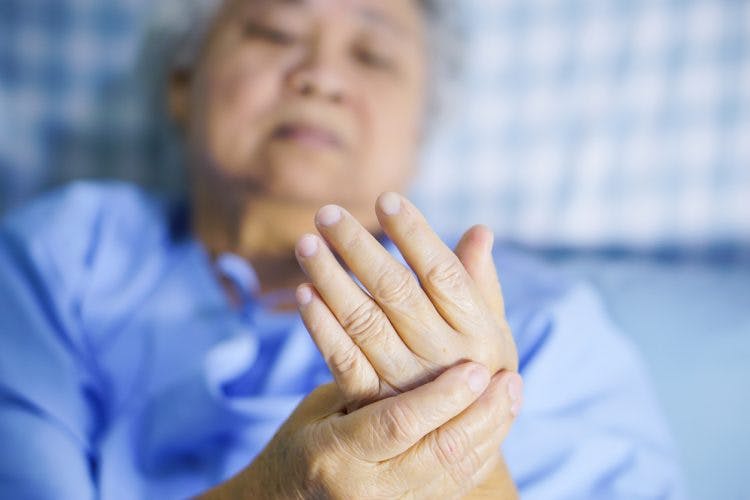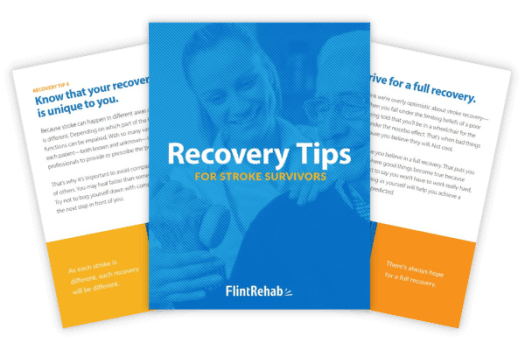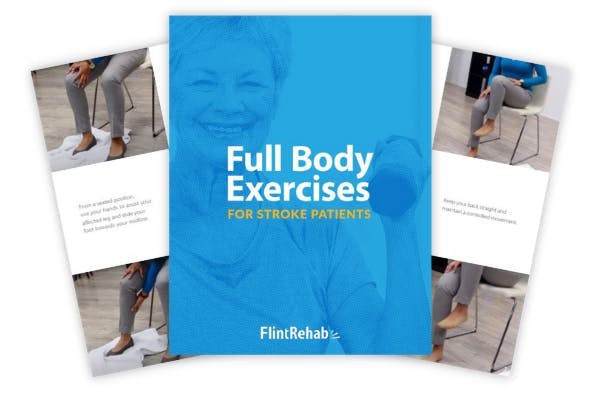No products in the cart.
No products in the cart.
No products in the cart.
No products in the cart.
Home » Neurological Recovery Blog » Stroke » Tremors After Stroke: Symptoms, Causes, & Treatment
Last updated on January 31, 2023

Post-stroke movement disorders, such as tremors, affect 1-4% of stroke survivors. Tremors after stroke are characterized by rhythmic, unintentional shaking of one or more body parts. However, tremors are not the only post-stroke movement disorder that can cause involuntary movement. Therefore, it’s important for survivors to work with their medical team for an accurate diagnosis.
This article will describe the symptoms and causes of tremors after stroke and discuss how to differentiate between tremors and other movement disorders. An overview of the best treatments to manage and reduce tremors after stroke will also be included.
Use the links below to jump directly to any section.
Tremors involve unintentional, uncontrollable rhythmic movement in one or more parts of the body. They can be classified either as action or rest tremors, meaning that they may occur while the muscles are either voluntarily contracted or supported in a relaxed position, respectively.
While rest tremors fall into their own category, action tremors may be further categorized as:
Action tremors are most common after stroke, but some survivors may experience resting tremors or a combination both types. While the hands and arms are often affected, tremors after stroke may affect various area of the body, including the arms, hands, legs, head, or even the soft palate of the mouth.
While many secondary effects of stroke occur within minutes to hours after the incident, tremors often have a delayed onset. Of all the post-stroke movement disorders, tremors have the longest delayed onset, occurring anywhere from 1 month to four years after the stroke.
Tremors are just one of many types of post-stroke movement disorders. Since many of these movement disorders have similar characteristics, it may be difficult to distinguish them from one another.
A few common conditions that may be confused with tremors after stroke include:
In addition to being a secondary effect of stroke, tremors may also be associated with a number of other conditions. Some of these conditions are neurologically based, such as Parkinson’s disease or multiple sclerosis. However, other types of tremors, such as essential tremors, may be passed on genetically. Due to tremors after stroke having a delayed onset, it can be difficult to determine their underlying cause because new conditions may have developed.
Since an accurate diagnosis is essential to determine an appropriate treatment, it’s important for survivors to consult their doctor about any involuntary movements they may be experiencing. This can allow one’s medical team to make accurate and effective recommendations to manage and/or improve tremors after stroke or other post-stroke movement disorders.
Secondary effects of stroke vary depending on the area(s) of the brain affected. While tremors after stroke are often caused by a stroke in the thalamus or basal ganglia, damage to other areas of the brain may also result in tremors.
Furthermore, the damage to specific areas of the brain may also be correlated with a specific tremor type or tremors in certain areas of the body. The following list includes many of the areas of brain damage that may cause tremors after stroke, as well as possible symptoms associated with each area of damage.
Although damage to each of these areas of the brain may cause tremors, it is important to remember that tremors are a relatively uncommon effect of stroke. While tremors are more likely to occur following a hemorrhagic stroke, they may also occur after an ischemic stroke.
In addition to individuals developing tremors after stroke, some survivors with an existing tremor at the time of their stroke may find that their tremors improve or disappear after stroke. This is a relatively rare occurrence, but it does demonstrate that different brain areas may be involved with the development of tremors.
There are various effective treatments and management strategies for tremors after stroke. Pursuing appropriate treatments can help not only slow the progression of tremors after stroke, but can potentially result in fully recovering typical voluntary movements.
While pursuing recovery is ideal, many survivors find that tremors after stroke resolve on their own, a phenomenon referred to as spontaneous recovery. Since not all survivors experience spontaneous recovery, taking action upon the onset of tremors is the best way to ensure an optimal outcome.
With this in mind, here are some of the best treatment options to resolve tremors after stroke:
A physical therapist can provide exercises to improve strength, coordination, and muscle control affected by tremors. The goal of physical therapy is to both strengthen the involved muscles and promote neuroplasticity (adaptive brain rewiring) through massed practice. By retraining the brain to accurately send signals to affected body parts, coordination may improve and the tremors may improve.
Want 25 pages of stroke recovery exercises in a PDF? Click here to download our free Stroke Rehab Exercise ebook now (link opens a pop up for uninterrupted reading)
While physical therapy is one of the best treatment options, some individuals require pharmacological interventions to improve. Doctors may prescribe various medications, such as anti-seizure medications, tranquilizers, or beta blockers, to help reduce tremors after stroke.
In severe cases of tremors after stroke, deep brain stimulation may be used. During this surgical procedure, doctors insert a long, thin electrical probe to the region of the brain causing the tremors. This probe is connected to a stimulator device that’s then implanted in the chest. The probe then transmits painless electrical pulses to interrupt the signals from the brain that might be causing tremors to occur.
Deep brain stimulation is an invasive, risky procedure. Therefore, it’s only used for the most severe cases and after other treatments have failed. However, deep brain stimulation has been demonstrated to be a promising treatment that may be effective for more than 70% of survivors with post-stroke movement disorders such as tremors.
While Botox and baclofen are common treatments for spasticity after stroke, they may also be used to treat tremors in some cases. Botox is typically injected directly into affected muscles, while baclofen can be administered through an implanted pump.
Although there have been few studies on the effectiveness of Botox in improving tremors after stroke, the results are promising. Similarly, there is limited research on the effects of baclofen on tremors after stroke. However, some survivors using baclofen for spasticity reduction have also reported improvements in their tremors after stroke.
Therefore, survivors struggling with both spasticity and tremors after a stroke may benefit from trying either Botox or baclofen to potentially improve one or both conditions. Doctors can determine whether these medications may be appropriate for a survivor’s specific condition.
An alternative treatment for tremors after stroke is utilizing behavioral techniques, such as introducing relaxation methods or focusing on stress management. Since stress and anxiety may worsen tremors, this alternative form of therapy may help.
Again, there is limited evidence of the effectiveness of behavioral techniques for treating tremors after stroke. However, these techniques have been shown to be helpful for individuals experiencing essential tremors.
While many survivors ultimately would like to recover from tremors after stroke, using compensation techniques throughout the recovery process can reduce the effects of tremors on one’s daily life. An occupational therapist can help survivors determine which compensation techniques or adaptive equipment would be most helpful.
While techniques differ depending on which area of the body is affected, some common compensation techniques for tremors after stroke include using weighted or steadying utensils or switching to voice typing. Use this link to see more devices and techniques that can be used to compensate for tremors after stroke.
With the above treatments, many survivors are able to find complete relief from tremors after stroke. Doctors and therapists can be excellent resources for survivors to discuss treatment options with in order to achieve optimal recovery outcomes.
Tremors after stroke involve uncontrollable, rhythmic shaking movements that often affect the hand and arms, but can occur anywhere in the body. Tremors after stroke often have a delayed onset, and they can also be caused by other conditions like Parkinson’s disease. Therefore, it’s essential to work with one’s medical team for accurate diagnosis.
There are many effective treatment methods for tremors after stroke, ranging from conservative treatments such as therapy and medications to more invasive techniques like deep brain stimulation. Every stroke is different, so the best treatment plan varies from person to person. Survivors should consider talking with their doctor or therapists to determine a treatment plan tailored to their recovery.

Get our free stroke recovery ebook by signing up below! It contains 15 tips every stroke survivor and caregiver must know. You’ll also receive our weekly Monday newsletter that contains 5 articles on stroke recovery. We will never sell your email address, and we never spam. That we promise.


Do you have these 25 pages of rehab exercises?
Get a free copy of our ebook Full Body Exercises for Stroke Patients. Click here to get instant access.
“My name is Monica Davis but the person who is using the FitMi is my husband, Jerry. I first came across FitMi on Facebook. I pondered it for nearly a year. In that time, he had PT, OT and Speech therapy, as well as vision therapy.
I got a little more serious about ordering the FitMi when that all ended 7 months after his stroke. I wish I hadn’t waited to order it. He enjoys it and it is quite a workout!
He loves it when he levels up and gets WOO HOOs! It is a wonderful product! His stroke has affected his left side. Quick medical attention, therapy and FitMi have helped him tremendously!”
FitMi is like your own personal therapist encouraging you to accomplish the high repetition of exercise needed to improve.
When you beat your high score or unlock a new exercise, FitMi provides a little “woo hoo!” as auditory feedback. It’s oddly satisfying and helps motivate you to keep up the great work.
In Jerry’s photo below, you can see him with the FitMi pucks below his feet for one of the leg exercises:
Many therapists recommend using FitMi at home between outpatient therapy visits and they are amazed by how much faster patients improve when using it.
It’s no surprise why over 14,000 OTs voted for FitMi as “Best of Show” at the annual AOTA conference; and why the #1 rehabilitation hospital in America, Shirley Ryan Ability Lab, uses FitMi with their patients.
This award-winning home therapy device is the perfect way to continue recovery from home. Read more stories and reviews by clicking the button below:
Grab a free rehab exercise ebook!
Sign up to receive a free PDF ebook with recovery exercises for stroke, traumatic brain injury, or spinal cord injury below: